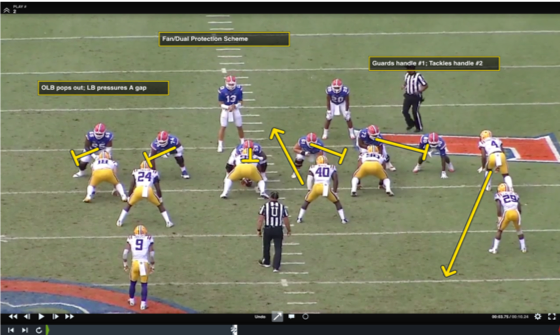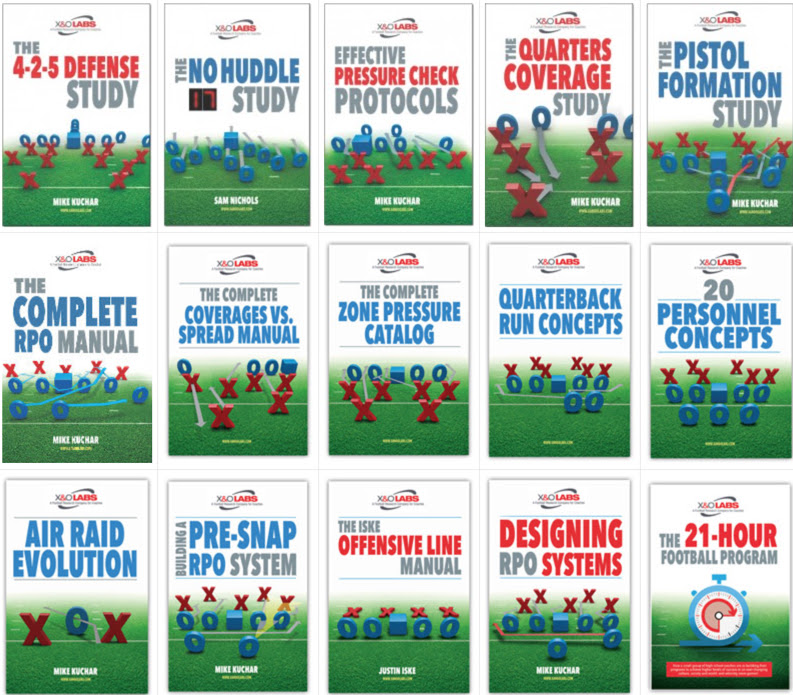
The Simulated Pressure System
The low-risk, high-reward pressure package that is super-easy for defensive coordinators—and a flat-out “nightmare” for offensive coordinators, quarterbacks, o-line coaches, and running backs… because it gives your defensive coordinator the ability to dictate, then manipulate protection schemes.
By Mike Kuchar
Senior Research Manager
X&O Labs
Twitter: @MikeKKuchar
If you haven’t heard of Simulated Pressures, or “Replace” blitzes as they are also known, don’t worry. You’re not alone. It’s the hottest new pressure trend this off-season—and for good reason. This new pressure system flat-out keeps offensive coordinators in a lose/lose situation by bringing control back to the defense.

My research team and I have been tracking this system for a few years. It’s the brain-child of some of the most effective defensive minds in all of football…
- Dave Aranda, Defensive Coordinator, LSU
- Pete Golding, Defensive Coordinator, Alabama
- Ron Roberts, Defensive Coordinator, University of Louisiana
In simple terms, Simulated Pressure is four-man rushes that attack an aspect of the protection or blocking scheme by overloading that particular player or side. This part of it is no different than any other pressure package. But, the difference in Simulated Pressure is that by only sending four in the rush (and not five), coverage isn’t compromised like a traditional fire zone.
That’s the simple explanation, but here’s why Simulated Pressure has garnered its “nightmare” reputation…
With Simulated Pressure, you get pressure with the player you want against the protector you want to attack, and you still have your full catalog of three deep and two deep zone coverages. How? You give all 11 of your players a legitimate role as a rusher. This is key to the system because the illusion of pressure can be as productive as pressure in certain situations. By rushing all of your 11 defenders at some point during a season, the offense has to legitimately account for each defender when they “bluff” or show pressure early. In turn, this allows you to dictate protection in one area and rush four from another.
“It just made more sense to attack protections and that’s the thing that these Simulated Pressures do,” Dave Aranda, LSU’s defensive coordinator, told X&O Labs exclusively. “You’re not overloading a protection, you’re stressing it. You’re getting the right one-on-ones. If it’s a full slide protection team, we will overload the back who is blocking the edge. If we are showing double edge from an Odd front, we will usually draw a fan dual protection and we’ll get an A gap rusher such as a linebacker on a running back. You get the pressure with the player that you want against the protector you want to attack and you’re still taking away the X or zoning-off crossers like you would in zone coverages.”
“With these pressures, you hold people by the nose and kick them in the butt.”
--Dave Aranda,
Defensive Coordinator, LSU
[Exclusive Interview]
Secret Sauce
If what you’ve read so far hasn’t piqued your interest in Simulated Pressure, here’s something we found that should convenience you to make the switch: What we found to be the “secret sauce” in studying these Simulated Pressures is how often the back is forced to stay in six-man protection. In this day and age where running backs have the potential to catch up to 83 balls a year as evidenced by Washington State University’s Air Raid systems, these concepts force backs to stay in and protect mainly because they don’t know where the pressure is coming from. When these pressures are combined with disguises, such as the mugs and bluffs, running backs are often wrong in their assignments, letting defenders have a free run at the quarterback. It’s a lose/lose situation for the offense.
Want Proof It Works?
In his first season at LSU in 2016, Coach Aranda used Simulated Pressure on 12% of pressure downs. The Tigers finished 15th in passing efficiency. Three years later, Coach Aranda used Simulated Pressures on 50% of pressure downs and his defense ranked 4th nationally in team passing efficiency. And this progression isn’t an outlier. Using this pressure system, Coach Aranda’s unit at Wisconsin followed the same meteoric progression, finishing in the top five in total defense his last two seasons there.
Just this past season, the University of Louisiana generated half of their entire sacks all season off these replace pressures. “We can run the same pressures from every front we carry into a game week, but we have the ability to switch who the outside and inside rushers are as well as a call to change the path of the two interior rushers,” said safeties coach Patrick Toney. “By having all these variables, the same pressures look drastically different week-to-week, which makes it incredibly tough for opposing offenses to prepare for.”
How Easy Is It to Run?
The process is simple and easy: You identify the protection scheme, select the personnel you want to attack them with and go. All this without sacrificing coverage. Best part is you don’t need dynamic pass rushers to get to the QB. It’s plug and play. Your pass efficiency defense will increase because you’re confusing the QB.
Do You Need Stud Pass Rushers?
The short answer is NO! That’s what makes Simulated Pressure so effective. It’s a great equalizer for programs that don’t have a great front-four because the offense has to account for all 11 of your defenders on any given play.
Is It Difficult to Install?
The simple answer is, “Heck, NO!” Simulated Pressure limits teaching from a defensive standpoint. You can use your same coverages that you would normally use on base downs, but now you can bring pressure behind it. It’s about doing more with less. It’s a safe way to pressure the QB with 7 in coverage. Being able to play traditional coverage while still being able to bring pressure maximizes your time coaching. Since you are running the same coverage you play on base downs, there is minimal new learning for your players, which allows them to rep and become proficient at the techniques, pattern reads and matches of the coverage. The other added benefit is that the presentation of the coverage looks drastically different to the opposing quarterback, because different defenders are dropping into the underneath zones and different rushers are coming. So, it’s simple for you and your players, but it’s super-difficult for opposing offenses.
Will Simulated Pressure Work at the High School Level?
We asked each of our collegiate coaches this same question. And Ron Roberts, defensive coordinator at the University of Louisiana and one the of the original architects of Simulated Pressure, said it best, “You will give guys in high school nightmares because they will not know how to protect it. Even at this level, teams will decide not to protect it by checking into max protect schemes.”
The Bottomline on Simulated Pressure
Simulated Pressure is proven to work, it’s easy for you to run—and hard for the offense to protect, you don’t need All-Americans in your front-four to be effective, its super-simple to install and it’ll bring “nightmares” to offensive coaches and players at the high school level.
All that sounded pretty good to us back when we started researching this concept—and we think the concept is even better now that we’ve spent months watching film, interviewing coaches, and conducting our research.
That is why I am proud to announce that we have just released a brand-new study called, The Simulated Pressure System, in our exclusive Insiders membership website.
X&O Labs’ Install Report for the Simulated Pressure System
When you join X&O Labs’ exclusive membership website, Insiders, you’ll get instant access to the full report detailing everything you need to install this ground-breaking pressure system in your program.
Here’s a short list of what you’ll find in this brand-new special report…
Case 1: Devising Pressure Patterns to Manipulate Protections
If this case was printed in a book, it’d be over 20 pages—and its chocked full of everything you need to install this system quickly and easily. But good for you, it’s available in our Insiders website so it includes plenty of video to show you what this system looks like in real-world situations. Plus, it includes diagrams and illustrations you can use with your coaching staff and players.
Case 2: Back End Coverage Structure and Responsibilities
This case is your step-by-step guide to coverage responsibilities for defenders in these Simulated Pressures. And we didn’t go light on this case either. This case would be a 20-page chapter if we had printed this in a book. This section also includes all the video, illustrations and diagrams for implementing with your coaching staff and players.
Case 3: Drilling the Rush and Cover Concepts in Simulated Pressures
As potentially elaborate as the Simulated Pressure scheme may be, its efficiency lies in drilling the fundamentals of both the cover defenders and rush defenders. In case three of this study, we provide you with all the drills and coaching points you need to get this installed quickly and effectively. Remember, teaching Simulated Pressures require teaching defenders to perform skills that they are not accustomed to performing. Therefore, we include in this case the exact system the coaches we spoke to developed and use to teach and drill players to defend any zone in coverage. This install drill system is the real reason Simulated Pressures is an easy install and effective on the field. It works.
BONUS CASE: Installation Methods for the High School Level
While Simulated Pressures have been populating the NCAA domain for the last few years, we realize many high school programs will be implementing these concepts for the first time. As a result, we wanted perspective from a high school program with experience using these schemes, particularly a smaller program with lower numbers that needs to maximize time to get these established. Our source came from Lexington High School in Missouri, where defensive coordinator Kyle Cogan has been using them for the last couple of seasons.
Join the Insiders and Get Started with Simulated Pressures!
When you join X&O Labs’ exclusive Insiders membership website, you’ll get instant access to our brand-new special report, The Simulated Pressure System. Plus, you’ll also get full access to every report, video, drill and study we’ve ever published. Our Insiders website is without question, the largest research resource for football coaches in the world. No other resource comes close.
And because we’re coaches just like you, we’ve made our membership prices affordable. Individual memberships are just $59.99 per year or you can register your entire coaching staff (up to 20 coaches) for the low price of $149.99 per year.
Plus, your Insiders membership comes with a 90-day money-back guarantee. When you sign up today, try it for the next 90-days. If you don’t think your membership is worth the money you paid, just let us know within your first 90-days and we’ll refund 100% of your money.
Best of all, when you join today, you will select a free book from our best-selling bookstore, and we’ll mail it directly to your home or office. BUT… if you register today with a STAFF MEMBERSHIP, you get 4 FREE books! That’s $160 in free books when you join with a Staff Membership.
Click the link below to start your registration. It only takes 3-minutes and you’ll have access to The Simulated Pressure System and thousands of other videos, reports, drills, studies and diagrams to use this off-season!
Click Here to Start Your Registration!
You'll select your FREE book(s) on the registration page. Full list to choose from below...
